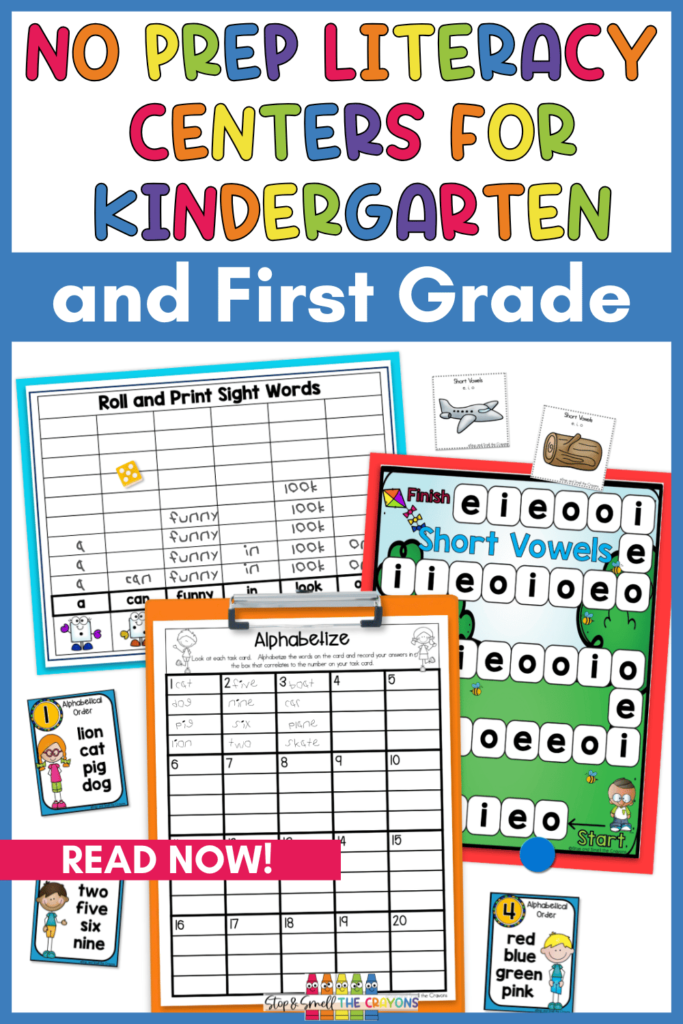One of my absolute favorite routines in my classroom has to be our literacy centers! They offer so much flexibility and keep my students totally engaged. I love that they allow us to review important skills or practice new ones with hands-on activities. Since I switch them up with the seasons, holidays, or our current theme, they never get stale. Now, as much as I love using literacy centers, I’m not a fan of activities that need a ton of prep. Today, I’m sharing my favorite low-prep literacy centers for kindergarten and first grade that keep learning fun without taking hours to set up!
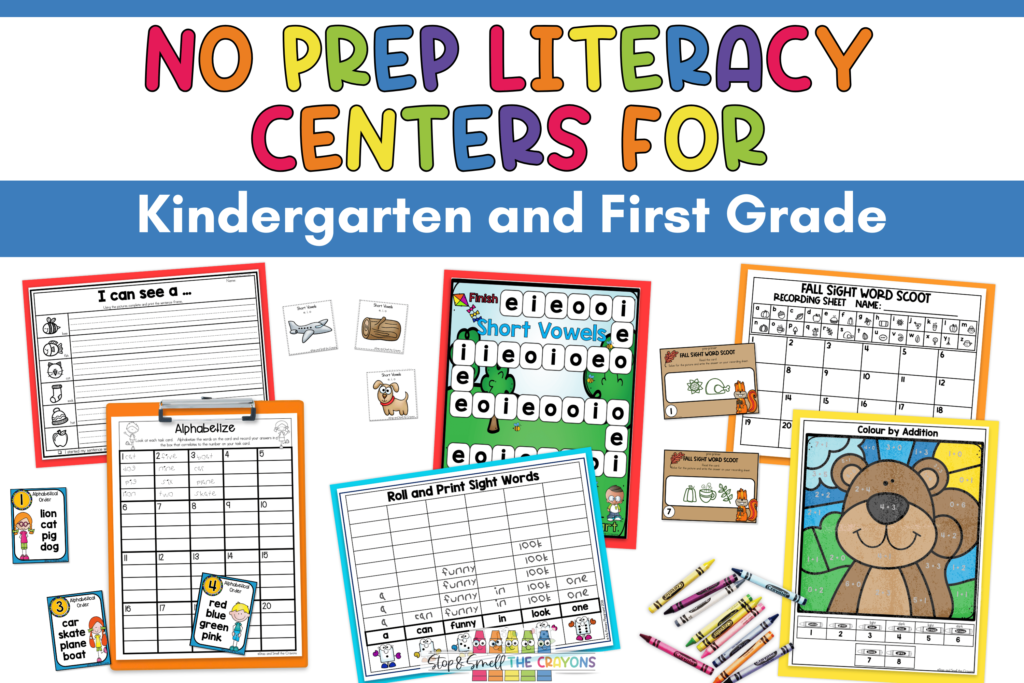
Benefits of Implementing Literacy Centers

Using literacy centers has transformed the way my students engage with learning. One of the biggest perks is how these centers create a space for active, hands-on practice. When I set up literacy centers, I know my students are getting a chance to explore essential literacy skills in a natural and exciting way, rather than just sitting with a worksheet. This approach helps deepen their understanding of phonics, vocabulary, and even comprehension, all while they think they’re just having fun!
Another key benefit is the independence these centers foster. From day one, my students learn how to navigate routines and make choices about their learning. This is a skill that grows with them. When they know what to expect from our literacy centers, they take ownership of their learning and feel more confident. As they work with classmates, they develop social skills like sharing ideas, helping each other, and even practicing patience.
For me, as a teacher, literacy centers are also a lifesaver because they provide flexibility in my planning. Low-prep literacy centers are a dream come true. They make it easy for me to keep the activities fresh and aligned with what we’re studying without hours of prep. Whether it’s switching up activities for different seasons, holidays, or themes, I can keep the learning relevant and exciting. Plus, these centers allow me to pull students aside for small-group work or individual check-ins and know that the rest of the class is getting some great skills-based practice.
Activities to Use in Literacy Centers
Below are several different activities that I rotate through my literacy centers. My students love each one. These activities keep things fresh and exciting. With each rotation, my students have new opportunities to engage, apply, and build on what they’ve learned! Plus, they don’t take long to prepare at all!
Writing Center Activity

This sentence starter and writing prompt resource is perfect for a writing center activity in the kindergarten or first grade classroom. Each page offers a sentence frame like “I can see a…” or “I like the…” alongside picture options for students to complete their sentences. This setup is fantastic for practicing beginning sentence structure and working on early writing skills in a low-pressure way. My students love choosing pictures to finish the sentences, which keeps them engaged and eager to write.
Using these sentence starters helps our students focus on starting with a capital letter, spacing words, and ending with a period. They do this all while building confidence in their writing abilities. These worksheets are print-and-go, so they fit perfectly into my low-prep philosophy. I can rotate them to keep the activity fresh, whether we’re focusing on vocabulary, describing objects, or practicing sentence building.
Alphabetical Order Cards

These alphabetical order worksheets make a fantastic addition to literacy centers. Each task card provides a set of words for students to arrange in alphabetical order. This is an excellent way for young learners to reinforce their ABC knowledge while practicing word organization. The setup is simple. Our students look at each card, put the words in the right order, and then record their answers in the matching boxes. This activity keeps their focus and gets them actively working with letters and vocabulary, all in a structured but hands-on way.
Using these alphabetical order literacy center task cards, I can see my students improve their skills with each rotation. They start recognizing patterns and picking up on alphabetical sequences more naturally, which is a big win for early literacy development. Since it’s low-prep, I can rotate these cards into my centers quickly without extra setup time. Each set can be used independently or in small groups, making it flexible and easy to adapt to different learning levels.
Task Cards

This Fall Sight Word Scoot activity is a great example of the interactive, low-prep literacy centers I use to keep my students engaged! In this activity, each student moves through a series of task cards. You can post them around the room for a write the room style activity or let students take the set of cards back to their desks. Whatever you choose, your students will love this activity that feels more like solving a puzzle than reading and spelling.
With these types of task card activities, kindergarten and first grade students are engaged and focused on decoding symbols to discover sight words. Not only does this activity support word recognition, but it also strengthens their spelling skills too.
Task card activities like this one are perfect for practicing sight words in a structured but dynamic way. They are always a go-to in my literacy centers. Since these are low-prep, I can rotate different task cards based on seasonal themes or skills we’re focusing on. This structure lets my students revisit sight words and decoding in various forms, reinforcing learning in an enjoyable way that keeps them coming back and excited for more!
BOOM Cards

My CVC Word BOOM Card activity shows that literacy centers can even be digital and interactive! With these BOOM Cards, students will work on their phonological awareness as they identify the correct letters to spell out short vowel words. They just drag and drop the letters into place based on the picture shown on each card. The added sound feature helps my students hear and recognize each word, making it perfect for reinforcing letter sounds and spelling.
In my literacy centers, BOOM Cards offer so much flexibility! I have a variety of BOOM Card sets that are perfect for helping kindergarten and first grade students focus on skills like identifying the beginning sound or matching words to pictures. This CVC spelling activity fits right in, allowing students to practice spelling in a self-paced, engaging way. Since BOOM Cards are self-grading and track progress, I get instant insights into how each student is doing without extra grading time.
BOOM Cards are also fantastic for keeping literacy centers low-prep. No need for printing or laminating! Our students simply grab a tablet or use the classroom computer to dive right into their tasks. I can easily differentiate activities within my literacy centers by selecting specific BOOM Card decks that match each student’s skill level or focus area. This digital option is a fun, effective way for our students to interact with literacy concepts independently!
Color By Code
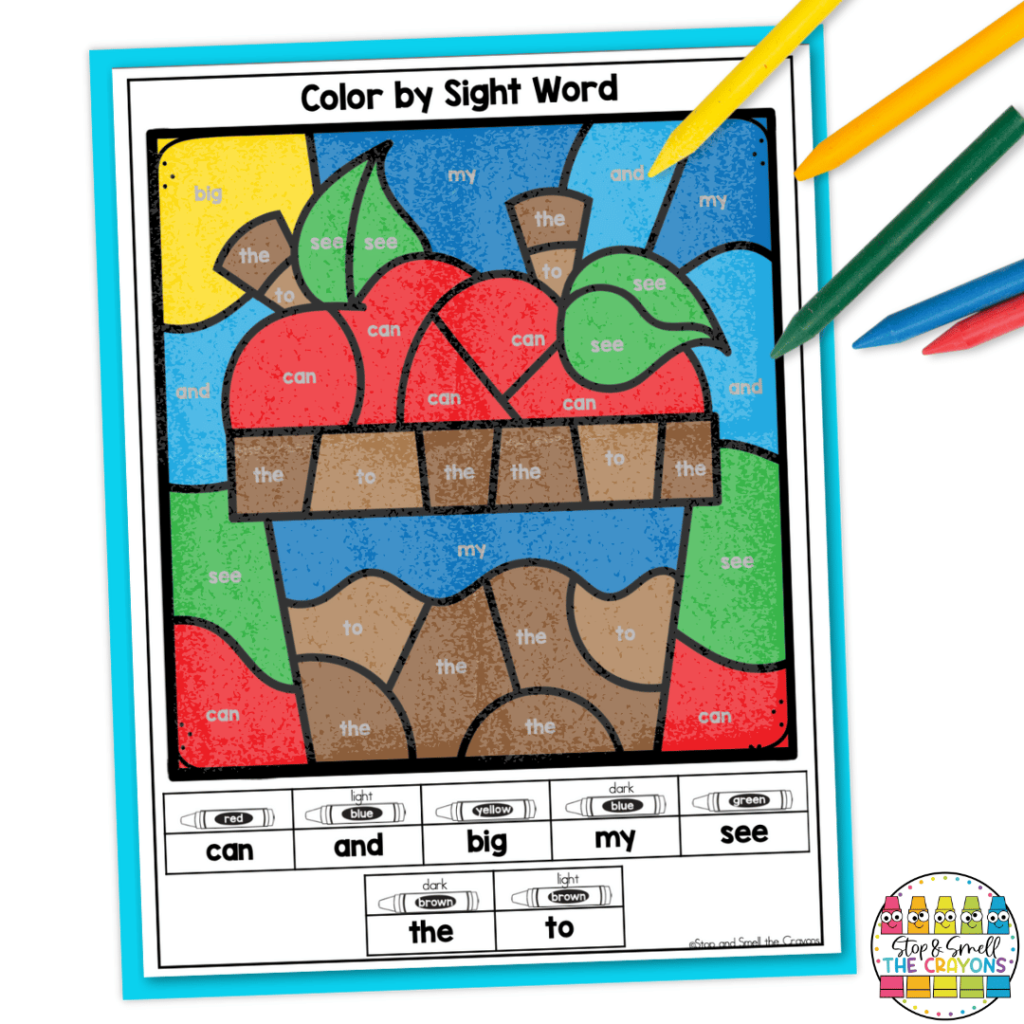
My Fall Color By Code activity is just one of the many ways I use coloring activities in my literacy centers to help my students practice sight words. These Color By Code pages combine sight word recognition with coloring. This creates a fun, hands-on way for our students to reinforce vocabulary while expressing creativity. Each section of the page is labeled with a sight word. Students color each area according to the code, revealing a picture by the end.
In my literacy centers for kindergarten and first grade, Color By Code activities allow my students to work independently, build their word recognition skills, and enjoy the process. An added bonus for me is that it can all be done with minimal prep on my end. Since I have different versions for various seasons and holidays, it’s easy to keep the activity fresh and exciting throughout the year. Whether they’re coloring scarecrows in the fall, a wintery scene in the winter, or flowers in the spring, these sheets give our students repeated exposure to sight words in a way that feels new each time.
Color By Code is also fantastic for building fine motor skills. Our students can practice coloring within specific areas while staying focused on recognizing and recalling sight words. This simple but effective addition to my literacy centers keeps learning engaging and provides a break from traditional worksheets while reinforcing literacy essentials.
Short Vowel Games
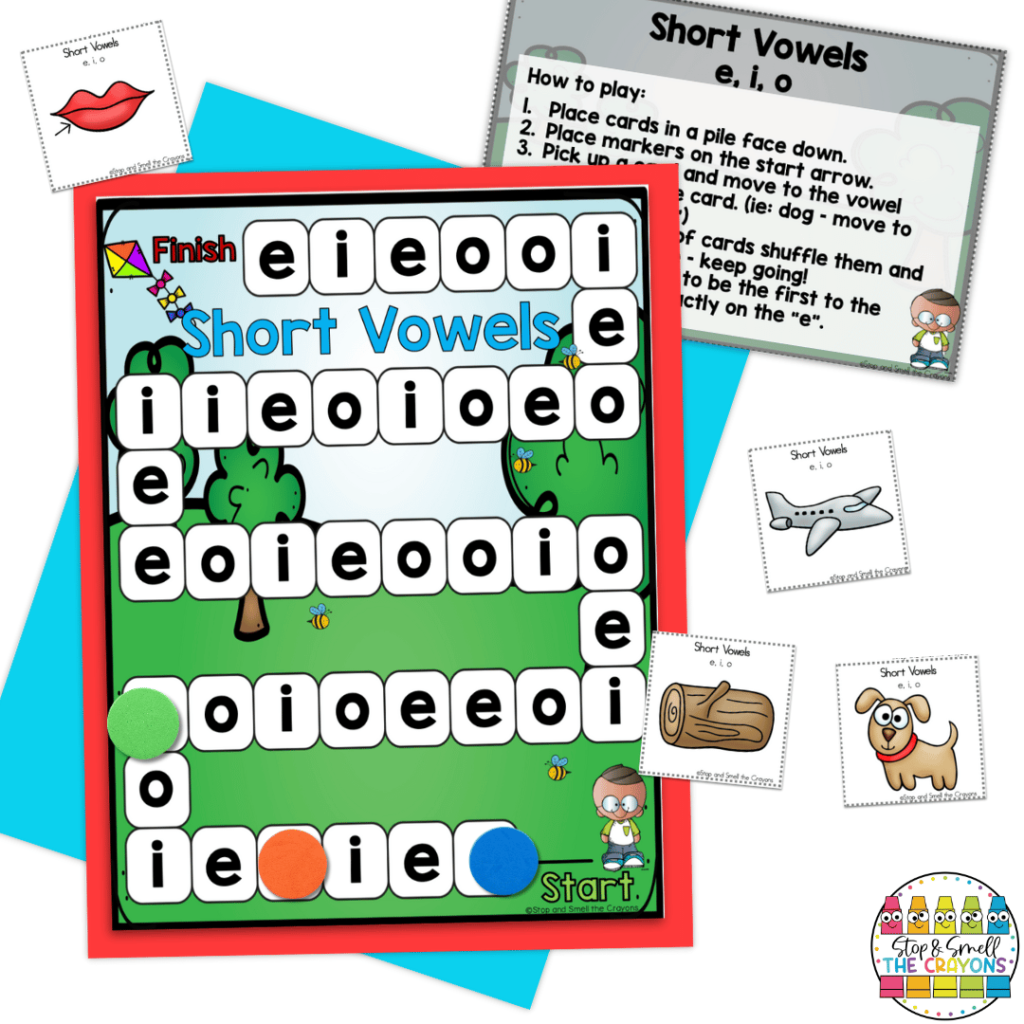
I love it when I am able to turn learning into a game! My CVC Vowel Games is a wonderful center activity when students are working on short vowels and CVC words. This particular activity includes cards where students move along a board based on the vowel sound in the word they draw, making it an engaging and effective way to reinforce early phonics skills.
In my centers, I love including activities like this one because it lets my students explore vowel sounds in a hands-on way that doesn’t feel like traditional practice. This activity gives my students the chance to engage with these essential skills repeatedly. Games like these make learning to read and spell with short vowels engaging and help our students build confidence in their skills and abilities.
Since this activity requires minimal prep, it’s an easy addition to my low-prep rotation. With games like this, I like to first play as a class or in a small group setting. This helps everyone to learn the rules and procedures of the game. Then I can add it to our center rotation and know that students can play independently.
I often switch out the vowel-specific games to align with our phonics focus for the week, ensuring that my students build their skills progressively. This CVC game set is just one of the many phonics-based activities I rotate, helping keep our literacy centers effective!
Roll and Print
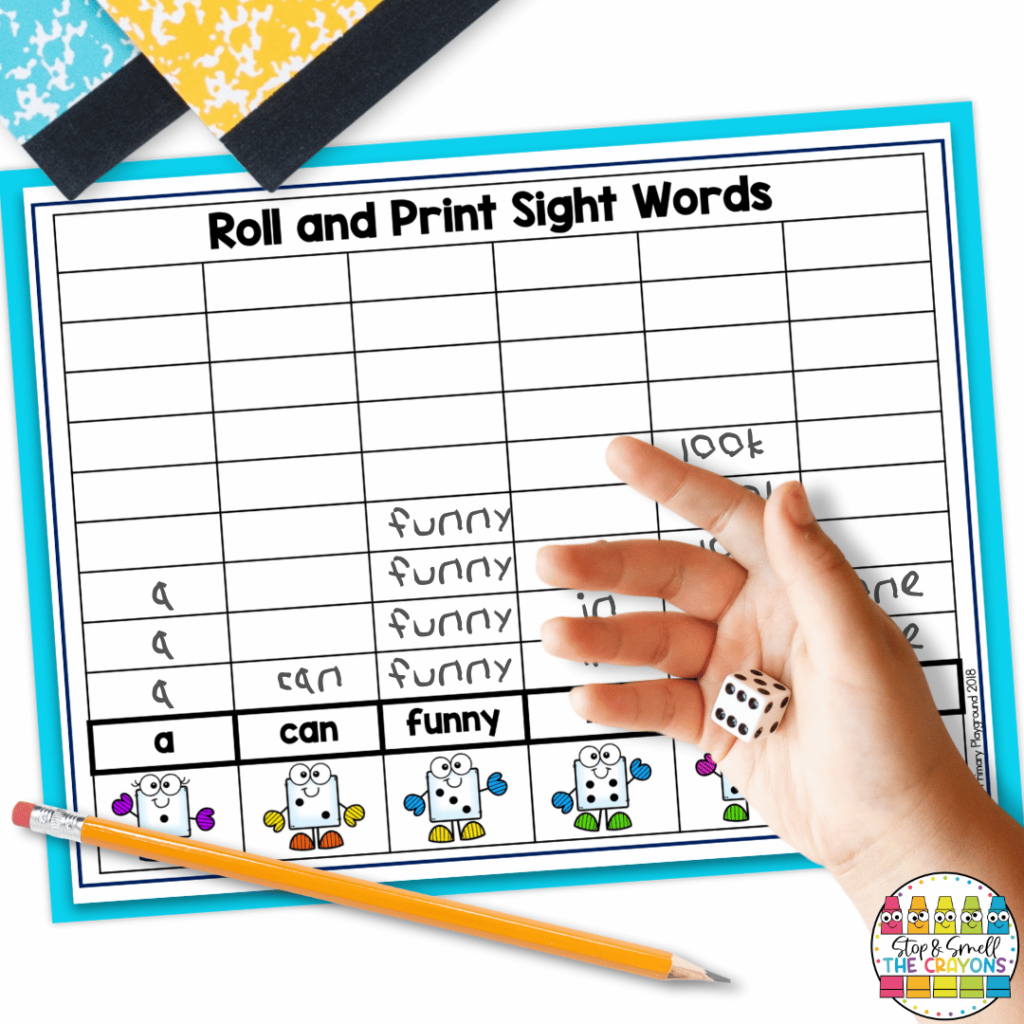
My Roll and Print Sight Words activity is a fantastic, low-prep addition to my literacy centers. This activity combines sight word practice with a fun game like feel by using dice. Each sheet has a list of sight words connected to one of the numbers on a die. Students roll a die and then they print the corresponding word in the space provided. This repetition helps them recognize high-frequency words and builds confidence in their reading and spelling abilities.
In my literacy centers, I love using activities like this because they’re straightforward, easy to set up, and effective. The hands-on approach lets my students focus on sight word recognition while improving fine motor skills as they write. I use different Roll and Print sheets so that I can differentiate the activity based on the sight words each student is working on. This keeps things relevant for my students while giving them continuous sight word practice, which is essential for early literacy development.
Additional Resources for Literacy Centers
These resources are just a glimpse of the low-prep center possibilities you can use in your literacy centers! Take some time to explore the resources below that will give you even more ideas for your center rotations.
- Fun and Engaging November Activities for the Elementary Classroom
- Winter Activities: Weaving Magic into Lessons
- Engaging Writing Activities Your Students Will Love
Plan Your Literacy Centers With Ease
These literacy centers for kindergarten and first grade are my go-to for keeping my students engaged, practicing essential skills, and building confidence. By using these centers, I can do all that without hours of prep! With activities like Roll and Print, Color By Code, task cards, and BOOM Cards, I can offer a variety of hands-on learning experiences that make literacy exciting and accessible for every student. I can easily rotate these centers to keep them fresh and relevant all year. So, if you’re looking for low-prep, high-impact ways to enhance your literacy centers, I hope you’re inspired to dive in and try these ideas in your classroom!
Save for Later
Remember to save this post to your favorite teacher Pinterest board for quick access to these no prep literacy centers!
